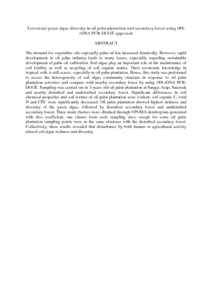Citation
Lim, Chin Tsong and Wong, Sing King and Bujang, Japar Sidik and Ahmad Ali, Siti Ramlah
(2016)
Terrestrial green algae diversity in oil palm plantation and secondary forest using 18S-rDNA PCR-DGGE approach.
International Journal of Agriculture and Environmental Research, 2 (3).
pp. 534-553.
ISSN 2455-6939
Abstract
The demand for vegetables oils especially palm oil has increased drastically. However, rapid development in oil palm industry leads to many issues, especially regarding sustainable development of palm oil cultivation. Soil algae play an important role in the maintenance of soil fertility as well as recycling of soil organic matter. Their taxonomic knowledge in tropical soils is still scarce, especially in oil palm plantation. Hence, this study was performed to access the heterogeneity of soil algae community structure in response to oil palm plantation activities and compare with nearby secondary forest by using 18S-rDNA PCR-DGGE. Sampling was carried out in 3-years old oil palm plantation at Sungai Asap, Sarawak and nearby disturbed and undisturbed secondary forest. Significant differences in soil chemical properties and soil texture of oil palm plantation were evident: soil organic C, total N and CEC were significantly decreased. Oil palm plantation showed highest richness and diversity of the green algae, followed by disturbed secondary forest and undisturbed secondary forest. Three main clusters were obtained through UPGMA dendrogram generated with dice coefficient, one cluster from each sampling sites, except for some oil palm plantation sampling points were in the same clusteras with the disturbed secondary forest. Collectively, these results revealed that disturbance by both human or agricultural activity altered soil algae richness and diversity.
Download File
![[img]](http://psasir.upm.edu.my/52940/1.hassmallThumbnailVersion/Terrestrial%20green%20algae%20diversity%20in%20oil%20palm%20plantation%20and%20secondary%20forest%20using%2018S-rDNA%20PCR-DGGE%20approach.pdf)  Preview |
|
PDF (Abstract)
Terrestrial green algae diversity in oil palm plantation and secondary forest using 18S-rDNA PCR-DGGE approach.pdf
Download (5kB)
| Preview
|
|
Additional Metadata
Actions (login required)
 |
View Item |

